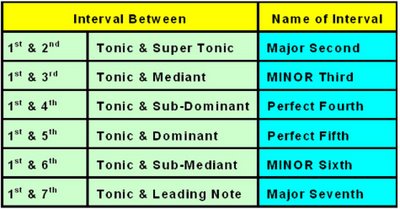Such a kind of similarity we have already seen regarding Harmonic Minor Scales w.r.t. Sharps. (Of course, some slight adjustment about the additional sharping the leading note is already clear in your mind).
If so, you can easily guess the sequence of Harmonic minor scales with Flats also.
The steps are just repeated to recall the procedures :
- Start with the A-Harmonic minor
- Proceed in terms of Perfect 5th downward each time from the previous minor scale.(or perfect 4th upward)
- Omitting the sharp required in the Leading note (7th note) , we can see the addition of flats each time which is similar to major scales in the same sequence and in numbers
- We can represent these flats in the key signatures in the same way that of Flat Majors, but in addition to that, the leading note is sharped (raised) every time separately in front of the note in stave wherever it occurs.
- Also, we can establish the equivalent Major and Minor scale relationships, in terms of the key signatures, which is separated by an interval of Minor Third. Thereby proving again that, for any Harmonic Minor Scale, there is an equivalent Major Scale (in terms of number and sequence of flats/sharps) whose tonic is a minor Third above the tonic of minor scale.
- Remember and be careful, using the proper accidental before the leading note every time.
With the above, our Harmonic Minor Scales sequence with flats are as follows :
[you can also check each scale with the standard pattern required for the Harmonic Minor Scale which is (Whole+Semi+Whole)+Whole+(Semi+One&Half+Semi) ]
Our standard sentence for flats sequence (reverse sentence of sharps),
“Battle Ends And Down Goes Charles Father” holds good.
Hope, now you can realise that, the system of forgetting the leading note first, helps us in getting a uniform system, similar to major scale approach and then adding back the effect of leading note separately, which is the simple task.
Caution :
While writing the notes in score sheet for Harmonic Minor, Please remember these:
· When you are using key signatures all the flats are taken into it and only the sharp or natural symbols are added in front of the leading note.
· If you are not using the key signatures, then all the notes shall be added with corresponding flats or sharps, but there is no need to add separate natural symbol for a leading note which is raised to normalcy (from presumed flatness).
That is to say, write a normal note as normal note only, and no need to add a flat and sharp symbol simultaneously in front of the leading note !
As done before for sharps, if we compare the Major & Minor scales equivalent in terms of flats for each of these scales, we get the confirmation that the tonics of each are separated by the interval of Minor 3rd !
Remembering these equivalence tables will help in undertsanding the Modualtion aspects later.
Yes….where have we reached now…?
15 Major scales and 15 Harmonic Minor scales….
We have travelled a long …long….way….!
Try to consolidate that ! In your mind and in your feeling !



